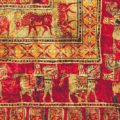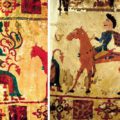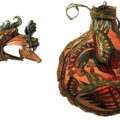From 5th to 3rd centuries BC, the Pazyryk culture, a Scythian culture of the Central Asia, thrived on the vast territory of the Altai Mountains. The Pazyryk people left a unique mark on history: their mounds and cave paintings are includes in the Tentative List for UNESCO World Heritage Sites.
Permafrost secrets
The Pazyryk culture got its name from the Pazyryk area, where in 1929 archaeologists found kurgans, or burial mounds of the tribal nobility of the people who lived here. These happened to be truly unique findings because of the ice lenses that formed under the kurgan mounds and have preserved, like in natural freezers, the fabrics, carpets, and wooden utensils, the little things that are usually destroyed by time in the first place. For example, a carpet made around 4th century BC was discovered in one of the kurgans, and it is considered the oldest existing tufted carpet in the world. In addition, the archaeologists have found well-preserved mummies in the permafrost. The Pazyryk culture is the only known ancient culture in Russia that practiced mummification of its dead. Why the nomads of Altai mummified the bodies or what were their beliefs is still a mystery, however, we have learnt some facts about their lives.
People of their time
By the middle of the 1st millennium BC, the nomads came to the vast expanses of the Eurasian steppes. People not only mastered pastoral nomadism as the new form of economic organization, but also started to move long distances. There were no borders between the tribes per se, and similar cultures developed on the territory from Asia to the Northern Black Sea region. They are known under the common term “Scythian world”. These nomadic cultures manifest themselves through similar weapons, horse harnesses and “animal style” in art.
Like many representatives of the Scythian world, the Pazyryk people were nomads: in winter, they would drive their herds to the highlands where there was less snow, and in summer, they would descend back into the grassland valleys. Researchers believe that in winter, the Pazyryk people lived in “stationary” log houses, and in summer, they moved from pasture to pasture, carrying their felt-covered, yurt-like houses along with them. Representatives of the Pazyryk culture were skilled artisans: products made of felt, leather, and wood show amazing craftsmanship and decorations. However, noble people wanted more than the products of local craftsmen, so they bought expensive imported goods. Silk and bronze mirrors from China, a carpet from Western Asia, camel wool and spices from Central Asia were found in the “royal” kurgans.
The Pazyryk people spent a lot of time in the saddle. This is evident from the number of horses buried in the kurgans in full harness and from the preserved garments such as short fur coats that are comfortable for riding, and felt boots/stockings. Another finding was pretty boots with beaded soles – obviously, they were not made for walking, but since the Pazyryk people did not have benches or chairs and sat on felt mats, such an elegant sole could be visible to everyone once you sit down with your legs crossed.
Women burial sites also contain elaborate wigs. For example, the wig from the Ak-Alakh kurgan was made of felt, fabric, hair and a special pliable substance. Men wore felt helmets with a crest in the form of a bird’s head or a fantastic animal. The helmets were fitted with a wooden plate. Interestingly, the Pazyryk helmets are the first material proof of the words of Herodotus, who wrote that the Scythians wore on their heads “high pointed turbans, dense, so that they stood straight.”
Faces of the Past
The archeologists who excavated the Altai kurgans were surprised to find out that the mummies that they found belonged to different anthropological types. Another surprise was people’s images on wooden pendants for horse harnesses, felt and carpets of the Pazyryk culture, because they depicted both Caucasian and Mongoloid people. Today, researchers believe that the Pazyryk people had a mixed anthropological type and that their population was formed as a result of close contacts between the local (autochthonous) people and migrants from modern-day Central and Western Asia, as well as some Mongoloid peoples of Eastern Siberia. In this sense, we cannot say what a typical representative of the Pazyryk culture looked like. The Pazyryk people are not defined through facial features, but through lifestyle, costumes, tangible and intangible culture, and, of course, tattoos.
Unread letters
Pazyryk tattoos are one of the reasons this culture receives so much attention. The tattooed pictures are largely zoomorphic: the Pazyryk people depicted hoofed mammals and predators, less often birds or fish, in the Scythian-Siberian animal style. There were also tattoos of mythical creatures such as a deer-griffin with hooves and a bird’s beak. Nomad usually wore only a fur coat, and when it was hot, it hang from the body held by a waist belt, revealing a tattooed torso and arms.
“Pazyryk tattoos are a reflection of a certain world, of specific worldviews and social relations in the society of ancient nomads,” says Alexey Tishkin, chief research fellow at the Laboratory of Interdisciplinary Study of Archaeology of Western Siberia and Altai at the Altai State University. “The Scythian-Siberian animal style is, if you like, the original form of writing used by the Pazyryk people.”
Scientists find the same animalistic and mythical motifs in the Altai petroglyphs. We can only guess their meaning. However, their value for humanity is well established. In 2018, five cultural and historical sites of the Altai Republic were included in the Tentative List of UNESCO World Heritage Sites as part of a single object, “Treasures of the Pazyryk culture”. It contains Pazyryk, Tuekta, and Katanda mounds as well as rock paintings of Kalbak-Tash and Elangash.
The rich historical heritage of the Altai Mountains has become one of the reasons for holding the first International Altai Forum under the provisional title “The Altai Vector of Eurasian Integration”.
Tatiana Borisova






